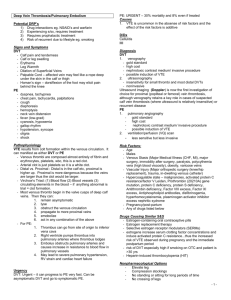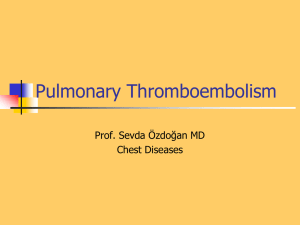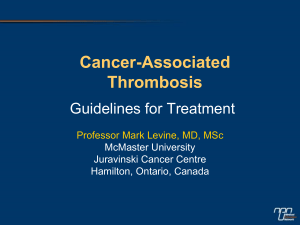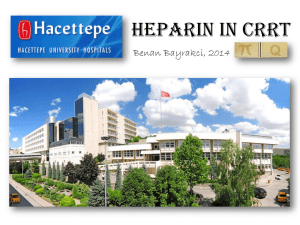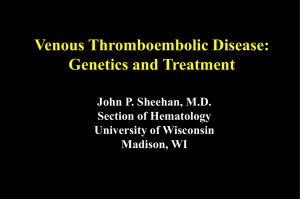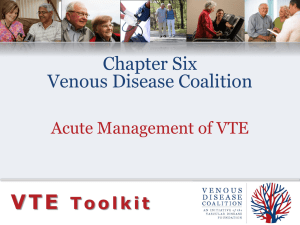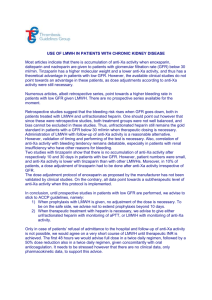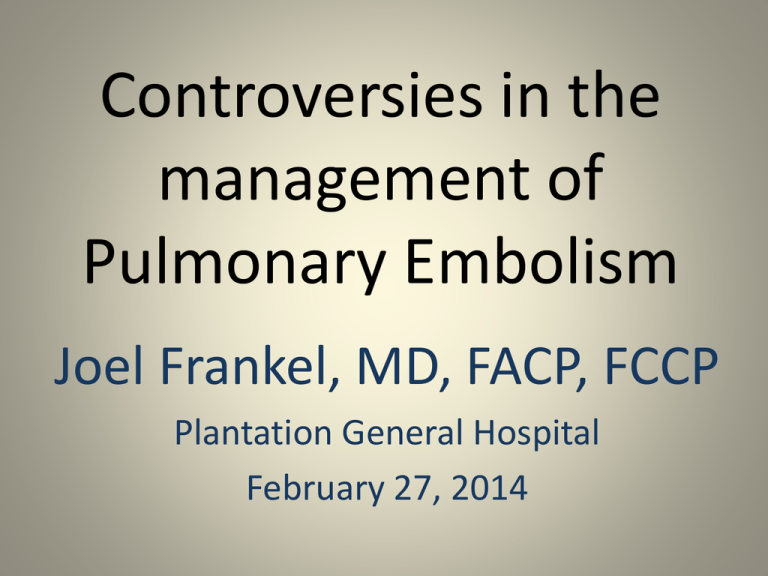
Controversies in the
management of
Pulmonary Embolism
Joel Frankel, MD, FACP, FCCP
Plantation General Hospital
February 27, 2014
Clinical Case
• 62 y.o. male presents to ED with 48 hours of
worsening dyspnea after returning from a 3 day
business trip to China
• Vitals: BP 110/60, P 102, O2 sat 86% on RA
• PE: Distended neck veins, RR w/o murmur, lungs
clear, normal LE exam
• D Dimer = 2496
• CT chest multiple thrombi in PA and dilated right
ventricle
• Management?
Questions
• Which form of Heparin?
– Lovenox (1 mg/kg SC)
– Unfractionated Heparin
• (80 U/kg bolus; 18 U/kg drip)
• Disposition
– ICU
– Medicine
– Home
Very Simple Goals
• Remember atypical cases
• Know why PE is missed
• Make your chart bullet proof
Why is the diagnosis delayed or missed?
•
•
•
•
•
•
Not considering the diagnosis
Presentation too atypical
PE looks like many diseases
The obvious miss
Misinterpretation of studies
Reliance on normal VS
Elevated troponin
•
•
•
•
Not just in MI !!!
Myocarditis, tachycardia
CHF, pericarditis, stroke, sepsis
Pulmonary embolism
Who do we miss the diagnosis in?
• Obese females on OCP
• Patients with medical comorbidities
The Pulmonary Embolism Rule-Out
Criteria (PERC) rule
• Less than 2% chance of PE if clinician pre-test
probability < 15% and all of the following:
–
–
–
–
–
–
–
–
Age < 50
HR < 100
SpO2 > 96%
No unilateral leg swelling
No hemoptysis
No recent trauma
No h/o VTE/PE
No OCP/exogenous estrogen use
PE myths
• All patients with PE are tachycardic
– About 50%
• Hypoxia is usually present
• Most patients have risk factors
– 20-25 % with risk factors
• Classic presentation common
Protective documentation
•
•
•
•
•
Thought process
Leg exam, Homan’s sign
Risk factor analysis
Clinical gestalt
Clinical decision rule
The chart
•
•
•
•
•
Any patient with cardiopulmonary symptoms
VTE risk factors
Attention to the VS
Leg exam
Evidence that you thought about VTE
Epidemiology
• PE is common
– 600,000-900,000 patients annually in US
• PE has high morbidity and mortality
– Mortality rate 10 – 17.5% overall
– Likely responsible for over 50,000 deaths annually
• Optimal management can improve these
outcomes
Questions for Discussion
• Which is the optimal form of heparin to be
used in the treatment of PE?
• Do all patients with a new diagnosis of PE
need to be admitted?
• When are thrombolytics indicated in the
management of PE?
Which is the optimal form of heparin
to be used in the treatment of PE?
• Options for bridging anticoagulation in acute
PE
– Unfractionated heparin (UFH)
– Low-molecular weight heparin (LMWH)
• LMWH has multiple potential advantages over
UFH
• Use of LMWH for most patients is standard of
care and recommended by multiple
professional societies
Evidence Supporting Use
• Multiple RCTs have established efficacy and
safety between LMWH and UFH for the
treatment of PE
– 3 month recurrence of VTE: 3.0% vs. 4.4 % (NS)
– Major bleeding: 1.3% vs. 2.1 % (NS)
Other Considerations
• LMWH is renally cleared – use with caution
with poor renal function
• UFH preferred in hemodynamically unstable
patients, especially if considering thrombolysis
• No clear difference in efficacy or safetey when
comparing once a day (1.5 mg/kg) vs. twice a
day (1 mg/kg) dosing regimens
Do all patients with a new diagnosis of
PE need to be admitted?
• Current standard of care is outpatient
management for DVT
• 30-40% of patients with DVTs have been found
to have asymptomatic PEs
• Although DVT and PE have different
outcomes, they exist on the same spectrum of
disease (VTE)
• Likely there is some group of low-risk patients
with PE that can be managed similarly to DVT
Aujesky et al 2011
• Open-label, multi-center, international, non-inferiority,
RCT
• 339 adult patients with confirmed acute PE
randomized to inpatient vs. outpatient management
• Outpatients treated with 1 mg/kg LMWH BID until INR
> 2.0 for > 2 days
• Primary end-point was recurrent VTE
• Secondary end-points included
– Major bleeding
– All cause mortality
Inclusion/Exclusion
Pulmonary Embolus Severity
Score of I or II (<86 points)
Points Assigned
Age
+1/year
Male
+10
Cancer
+30
Heart Failure
+10
Chronic Lung Disease
+10
Pulse > 100 bpm
+20
SPB < 100 mm Hg
+30
RR > 30 bpm
+20
T < 36 degrees C
+20
Altered Mental Status
+60
Oxygen Sat < 90%
+20
• Patients excluded if any of the
following
–
–
–
–
–
–
–
–
–
–
–
O2 sat < 90%
SBP < 100 mmHg
Chest pain requiring IV opiates
Active bleeding
Stroke within 10 days
GI bleed within 14 days
< 75,000 platelets
Cr Clearance < 30
Extreme obesity (>150 kg)
History of HIT
Already being treated with oral
anticoagulant
– Any barriers to follow up
Outcomes
Outpatient
Group (n=171)
Inpatient
Group (n=168)
P-Value*
Recurrent VTE
1 (0.6%)
0 (0%)
0.011
Major Bleeding
3 (1.8%)
0 (0%)
0.086
Mortality
1 (0.6%)
1 (0.6%)
0.005
Recurrent VTE
0 (0%)
0 (0%)
0.003
Major Bleeding
2 (1.2%)
0 (0%)
0.031
Mortality
0 (0%)
0 (0%)
0.003
90-day
outcomes
14-day
outcomes
*P-value represents one-sided p-value for non-inferiority
Erkens et al 2010
• Retrospective cohort study of consecutive
patients with confirmed acute PE
• Decision for outpatient treatment by treating
physician based on hospital protocol
–
–
–
–
SPB > 100 mmHG
O2 sat > 92%
No contraindication to LMWH
Does not need admission for other reasons
• Outpatients treated with LMWH
• Patient followed-up at 14 days and 90 days
Outcomes
Outpatient Group
(n=260)
Inpatient Group
(n=213)
P-Value*
Recurrent VTE
10 (3.8%)
10 (4.7%)
0.654
Major Bleeding
4 (1.5%)
17 (8.0%)
0.001
Readmission Rate
6 (2.3%)
11 (5.2%)
0.135
Mortality*
5 (5%)
57 (26.7%)
<0.001
Recurrent VTE
1 (0.4%)
4 (1.9%)
0.180
Major Bleeding
0 (0%)
13 (6.1%)
<0.001
Readmission Rate
4 (1.5%)
4 (1.9%)
1.0
Mortality*
1 (0.4%)
27 (12.7%)
<0.001
90-day outcomes
14-day outcomes
Are there other factors that can help
risk stratify patients?
• Troponin is a predictor of complicated clinical
course or death
– NPV for death 96-97%
– NPV for complicated clinical course 92-94%
• Pro-BNP is a predictor of mortality or adverse
outcomes
– NPV for death 99%
– NPV for adverse outcome 95%
• RV dysfunction on CT
– NPV for PE related death 100%
Take Home Message
• Outpatient management of PE is not common practice
currently, but feasible and safe in selected low-risk
patients with acute PE
• Standard of care is likely to shift in the near future
given pressures to lower resource utilization
• It is reasonable to offer outpatient management in the
patient with low PE severity index, normal BP, normal
O2 sats, normal EKG, normal troponin, normal pro-BNP,
and no evidence of RV dysfunction
• An informed discussion with the patient and careful
documentation are necessary to attempt this approach
When are thrombolytics indicated in
the management of PE?
• Risk of Bleeding with Thrombolysis in PE
– Fatal Hemorrhage: 0.5 %
– Intracranial Hemorrhage : 1.8-3.0 %
– Major Hemorrhage: 9-13 %
• Potential Benefits of Decreasing
– Mortality
– PE recurrence
– Pulmonary Hypertension
– In-Hospital Complications
Differences in Outcomes
• The mortality of patients with PE vary
depending on the clinical circumstances
– Cardiac Arrest: 66-95%
– Massive PE: 22-53%
– Submassive PE: 8-13%
– Uncomplicated PE: 1-4%
• The clinical circumstances should drive
decision making with the use of thrombolytics
Contraindications to Fibrinolytics
• Active internal bleeding
• Recent intracranial
bleeding
• Intracranial tumor or
seizure history
• Ischemic stroke within 2
months
• Neurosurgery within the
past 1 month
• Surgery within the past 10
days
• Puncture of noncompressible vessel
within past 10 days
• Trauma within 15 days
• Uncontrolled HTN (SBP
> 180; DBP > 100)
• Hemorrhagic disorder
or thrombocytopenia
(<100,000)
• Impaired hepatic or
renal function
• GI bleeding within 10
days
• Pregnancy
Cardiac Arrest
•
•
•
•
10-20% of all PE cases
Dismal outcomes with 66-95% mortality
No RCTs address this clinical scenario
3 major studies show significant increase in ROSC
rate and trend toward increased survival in
cardiac arrest
• Overall bleeding complication rare is low when
used in cardiac arrest
• Multiple professional societies have supported
use of thrombolytics in this clinical situation
Bottiger et al 2001
• 90 patients with out-of-hospital cardiac arrest
undergoing CPR without ROSC within 15 minutes
• 40 patients received 50 mg tPA and 5000 U of
heparin as bolus vs. 50 patients with standard
ACLS
–
–
–
–
ROSC: 68% vs. 58% (p=0.026)
Survival to ICU admission: 58% vs. 44% (p=0.009)
24 hr Survival: 35% vs. 22% (p=0.171)
Hospital Discharge: 15% vs. 8% (NS)
• No CPR related bleeding complications
Lederer et al 2001
• 324 patients with out-of-hospital cardiac arrest
undergoing CPR
• 108 received 50 mg tPA as bolus vs. 216 with
standard ACLS (retrospective)
– ROSC: 70.4% vs. 51.0% (p=0.001)
– 24 hr Survival: 48.1% vs. 32.9% (p=0.003)
– Hospital Discharge: 25% vs. 15.3% (p=0.048)
• Bleeding complications low
– ICH 0.9% vs. 0.9% (NS)
– Major Hemorrhage 4.6% vs. 2.3% (NS)
Bozeman et al 2006
• 163 patients in cardiac arrest undergoing CPR
not responding to standard ACLS (prospective)
• 50 received 30-50 mg tPA bolus vs. 113
controls with standard ACLS
– ROSC: 26% vs. 12.4% (p=0.04)
– Survival to ICU admission: 12% vs. 0% (p=0.0007)
– 24 hr Survival: 4% vs. 0% (NS)
– Hospital Discharge: 4%vs. 0% (NS)
• 1 patient with ICH in tPA group (2%)
Take Home Message
• Although not definitely studied in patients with
PE, likely benefit > risk to giving tPA in cardiac
arrest with PE is suspected cause
• Consider historical factors or bedside
ultrasonography to guide decision making
• When given, administer 50 mg tPA and 5000 U
UFH as IV bolus
• May repeat if no ROSC after 15 minutes
• If ROSC occurs, start continuous infusion of UFH
at 18 U/kg/hr
Massive PE
• 5% of all PE cases
• Mortality 22-53%
• 5 RCTs that included hemodynamically unstable
patients suggest benefit
• Meta-analysis of RCTs showed significant benefit
• 2 retrospective studies show trend to benefit
• Bleeding complications low in selected patients
• Multiple professional societies recommend use of
thrombolytics in this scenario
Wan et al 2004
• Meta analysis of 11 RCTs comparing thrombolysis +
heparin vs. heparin alone
• Subgroup analysis of 5 RCTs that included
hemodynamically unstable patients
• 128 patients received thrombolysis, 126 received
heparin alone
• Efficacy Outcomes
– Mortality: 6.2% vs. 12.7% (NS)
– Recurrent PE: 3.9% vs. 7.1% (NS)
– Recurrent PE or Death: 9.4% vs. 19% (p<0.05)
• Bleeding outcomes: 21.9% vs. 11.9% (p=0.05)
Take Home Message
• Data regarding benefit not definitive, but
benefit:risk ratio likely to support use in
hemodynamically unstable patients
• Consider use in select patients with CONFIRMED
PE and hemodynamic instability keeping in mind
patient risk for bleeding complications
• When given, infuse 10 mg tPA as bolus followed
by 90 mg infusion over 2 hours
• Should be followed by 80 U/kg bolus of heparin
followed by 18 U/kg/hr infusion
Submassive PE
• 23-40% of all PE cases
• Increased mortality when compared to
hemodynamically stable patients without RV
dysfunction (9.3% vs. 0.4%)
• Multiple studies have definitely shown
improvement in hemodynamic or radiographic
parameters, though improvement in clinical
outcomes remains mixed
Take Home Message
• Treatment of patients with submassive PE with
thrombolytics is highly controversial
• Current evidence is conflicting and filled with
multiple flaws
• Use of thrombolytics in this situation does not
carry overall support from professional societies
and is not standard of care
• Use of thrombolytics may be considered in select
patients with support from sub-specialists
Future Directions
• The Pulmonary EmbolIsm THrOmbolysis (PEITHO) trial is a multicenter international RCT (double-blinded, placebo controlled)
currently underway
• Includes patients with
– Confirmed acute PE
– RV dysfunction on Echo or CT chest
– Elevated Troponin
• Treatment Protocol
– Thrombolysis Group: tPA + UFH
– Control Group: UFH only
• Outcomes
– Primary: Composite of Death or Hemodynamic Collapse < 7 days
– Secondary: Death, Hemodynamic Collapse, Recurrent PE, ICH, Major
Bleeding
Follow-up on Initial Questions
• Which is the optimal form of heparin to be used in the
treatment of PE?
– LMWH in most cases
• Do all patients with a new diagnosis of PE need to be
admitted?
– There may be a group of very low risk patients that can be
managed primarily as outpatients
• When are thrombolytics indicated in the management of
PE?
– Clearly indicated in cardiac arrest from PE and massive PE
without contraindication to fibrinolytics
– Utility in submassive PE unclear
– Not indicated in uncomplicated PE


